The Curly Girl’s Guide to Dew Points, Humectants, & Humidity
This post may contain affiliate links, and I will earn a commission if you purchase through these links. Please read the disclosure policy for more details.
In this post, I break down dew points, humectants, emollients, and humidity so that you can confidently style your wavy and curly hair according to the weather. No more wasting time and product and going outside to totally ruin all your hard work!
After following the curly girl method for several years, I have the basics down and was able to learn about weather styling. Lucky for me, I live in a place with the same temps and dew point year round so I don’t have to switch up my products for the seasons. I just have to make sure it’s not full on raining because then I definitely need to bust out the hard hold gel and probably even leave some of the cast.
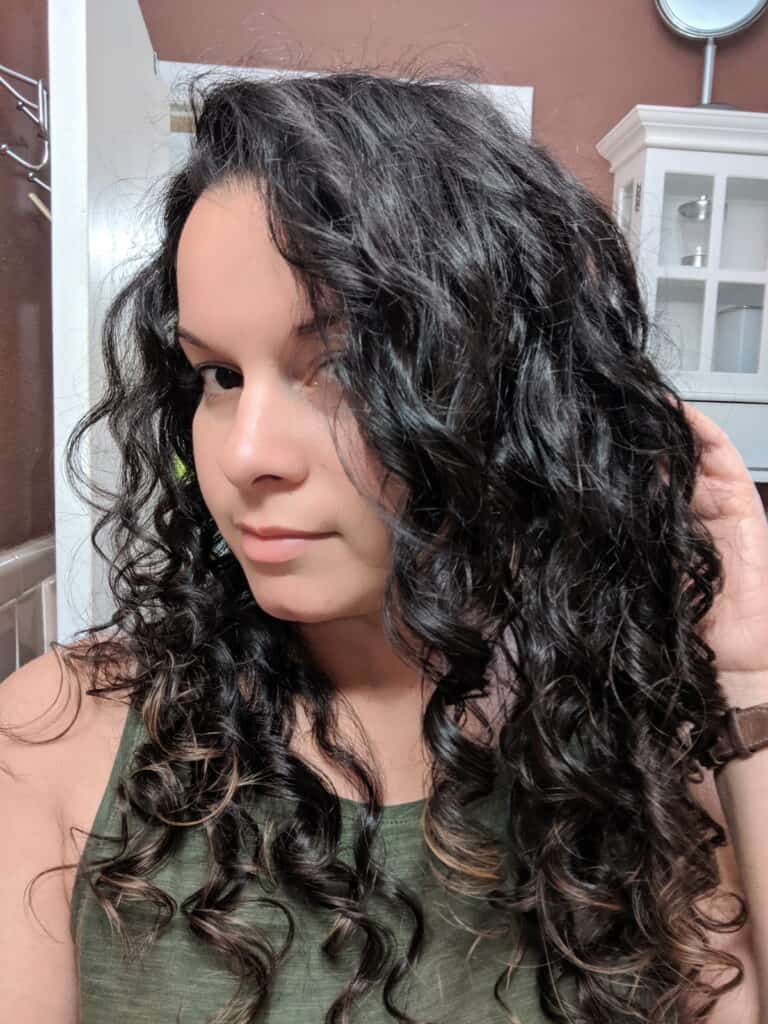
Humidity
Ah humidity! The nemesis of wavy and curly hair. Having lived most of my life in Miami, I am programmed to check the weather forecast before washing my hair so I know how I am going to style it.
In the past, this meant checking for the humidity to see if it was good enough to straighten my hair (usually it was not!). But now, I check it to decide which products to use when I style my curly hair.
Humidity is the amount of water vapor in the atmosphere. It is represented by a percentage. So for example, when it is raining it is 100% but when the weather is really dry it will be a much smaller number. Most weather reports include the humidity.

In high humidity, around 90% or so, curls tend to frizz and lose their shape quickly. McKay says, “In high-humidity conditions, this can cause curly hair to swell so much that cuticles are raised, making the surface of the hair very rough. These cuticles can then become entangled with cuticles of adjacent hairs and create a huge, tangled mass, which is prone to breakage. Also, curly hair swollen by excess water can lose its curl pattern, creating the dreaded summer frizz.”
This is the case in Miami, where the humidity usually hovers around 80%-100% year round. Summer is usually when humidity is the highest in most places, or the rainy season if you live in an area that has one.
So yeah, humidity is definitely not our friend. But I’m guessing you already knew that.
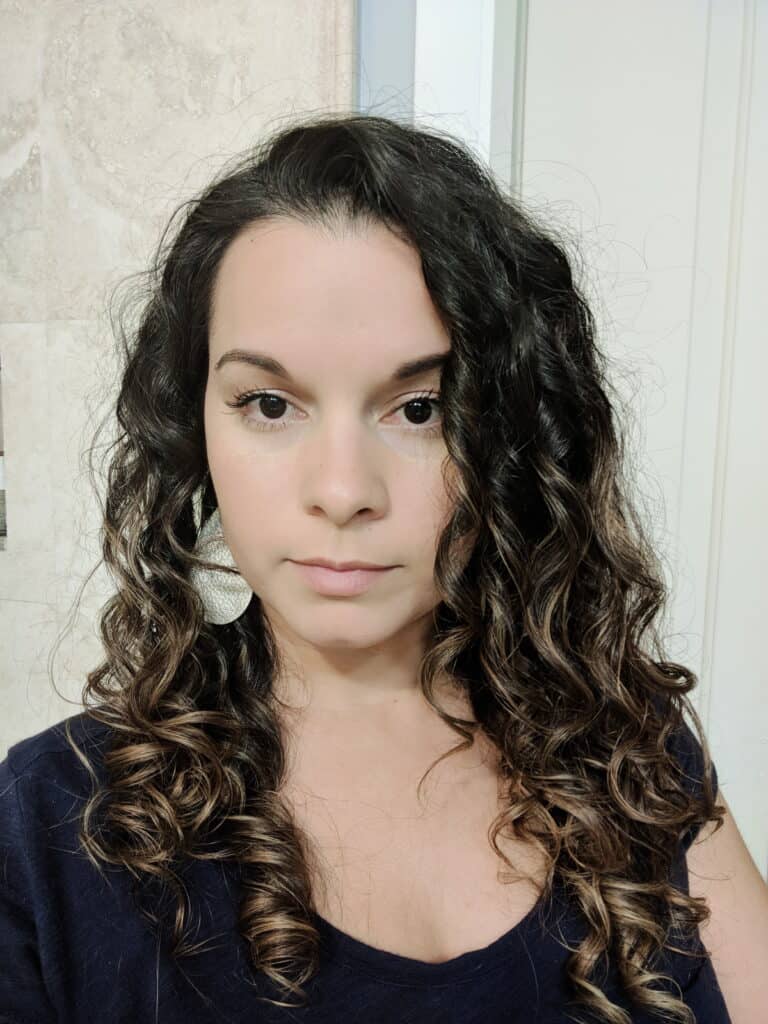
Dew Point
Humidity is usually the only weather concern people think of but what really affects our hair is the dew point. Dew point is the temperature at which a vapor begins to condense. It is the temperature that air has to be cooled to in order to reach 100% humidity. Basically, it’s the lowest temperature when water droplets start to form.
This number is actually more important than humidity when choosing the products we use on our hair. Why? Consider the following scenarios: You can have 90% humidity in 35°F/2°C weather and the humidity not affect your hair. Alternatively, you can have 60% humidity in 70°F/21°C weather and your curly hair could be full of frizz! This is because of the dew point.
If the dew point is 75°F/24°C and the air temperature is 85°F/29°C, the air temperature would need to be cooled to the dew point for it to rain. The hotter the air temperature becomes, the higher the dew point temperature can be (it can’t be higher than the actual temp though) and the more water vapor the air can hold. This is why 60% humidity at 70°F/21°C affects your curly hair more than 90% humidity at 35°F/2°C. At a higher dew point, the air can hold more water vapor which in turn causes frizzy hair.
Before I get into the recommendations for each dew point, I will explain humectants and emollients.
Humectants
Humectants are ingredients that reduce the loss of moisture by attracting water molecules, aka moisturizing ingredients. Humectants applied to the hair draw water to themselves from whichever source is greater — the atmosphere or the hair.
In high dew points, using humectants are usually a disaster. You’re attracting all the water vapor in the air to your hair, which then swells up and starts to frizz and tangle.
But they are also a disaster in low dew points. McKay says, “a humectant applied to your hair might be irresistibly drawn to the moisture in your hair and make every attempt to steal it from you (by drawing it out of your hair and binding it to itself). This can result in dry, fly-away hair, split ends, and broken strands.”
Some common humectants include:
- Glycerin
- Agave nectar
- Honey
- Algae extract
- Hydrolyzed collagen
- Propylene glycol
- Butylene Glycol
- Hyaluronic acid
- Sorbitol
- Glucose
- Fructose
- Hydrolyzed proteins: Elastin, collagen, silk, keratin
Film Forming Humectants
Some humectants are considered film forming, meaning they form flexible barriers that retain water in your hair. These are safe to use in low dew points because of the film (cast) they form.
- Flaxseed
- Okra
- Aloe Vera
- Hydroxyethylcellulose
- Pectin
- Xanthan Gum
- Guar Gum
- Marshmallow Root
- Slippery Elm
- Carrageenan (also known as Irish moss or seaweed extract, sea emollient, sea algae, sea vegetable)
- Nettle leaf tea
- Nettle extract
- Panthenol
- Hydroxypropyltrimonium honey

Emollients & Anti-Humectants
Emollients are usually hydrophobic oils that act as anti-humectants and seal the hair, like plant oils. Anti-humectants do not attract and in many cases repel water. These have traditionally been silicones, but many other ingredients function similarly to silicones.
Note that emollients can cause buildup or be too heavy for certain hair types. Check out my free Weather Styling Guide for more detailed info.
Some common emollients include:
- Argan oil
- C12-15 alkyl benzoate
- Grapeseed oil
- Mango butter
- Sunflower oil
- Cetyl esters
- Cocoa butter
- Coconut oil
- Jojoba oil
- shea butter
- avocado oil
- olive oil
- emulsifying wax
- peg 8 beeswax
Humidity Resistant Ingredients
Some products contain humidity resistant ingredients to help your hair tolerate excessive moisture in the air. Many of these ingredients do build up though so if you use products with these ingredients, you need to make sure you clarify regularly.
Often the products containing these ingredients are hard hold gels.
Humidity resistant ingredients include:
- Polyquaternium-4
- Polyamide-1
- Polyquaternium-10
- Polyquaternium-69
- Polyquaternium-11
- PVA/VP Copolymer
- VP/DMAPA Acrylates Copolymer
- Polyacrylate acid
- Polyacrylate-2 Crosspolymer
The photo below shows the ingredients list of the Giovanni LA Hold gel which is a hard hold gel that works well in high humidity and dew points. You can see the red is a humidity resistant ingredient and it’s high on the list in the second place. The black are film forming humectants, and the blue are emollients.
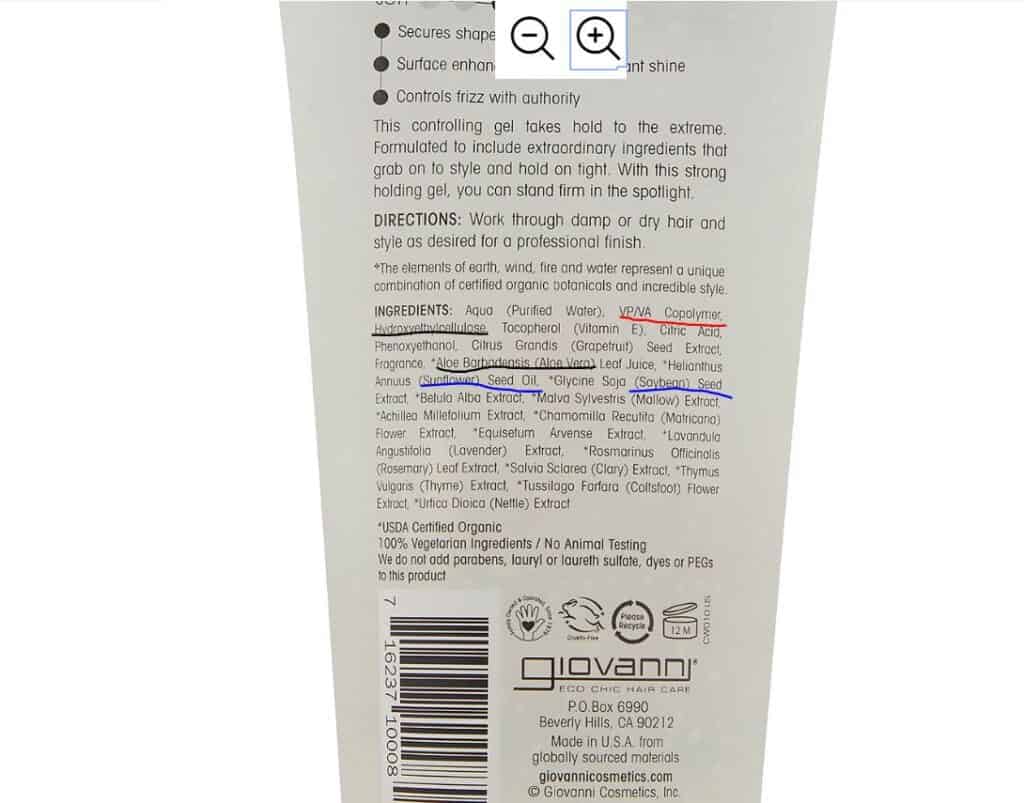
Now on to the part that you’re here for.
Styling According To Dew Point
You want to style your hair according to the dew point. Focus on the first 5 ingredients in each product and don’t worry about the rest. You can’t totally eliminate specific categories of ingredients easily and it’s not necessary.
Check your weather forecast before washing your hair so you know which products to use as leave-in and stylers. Frizz Forecast from Naturally Curly conveniently gives you all the info you need to make your styling decision based on the weather. Check out the image below what you can see when you enter your curl type and location.
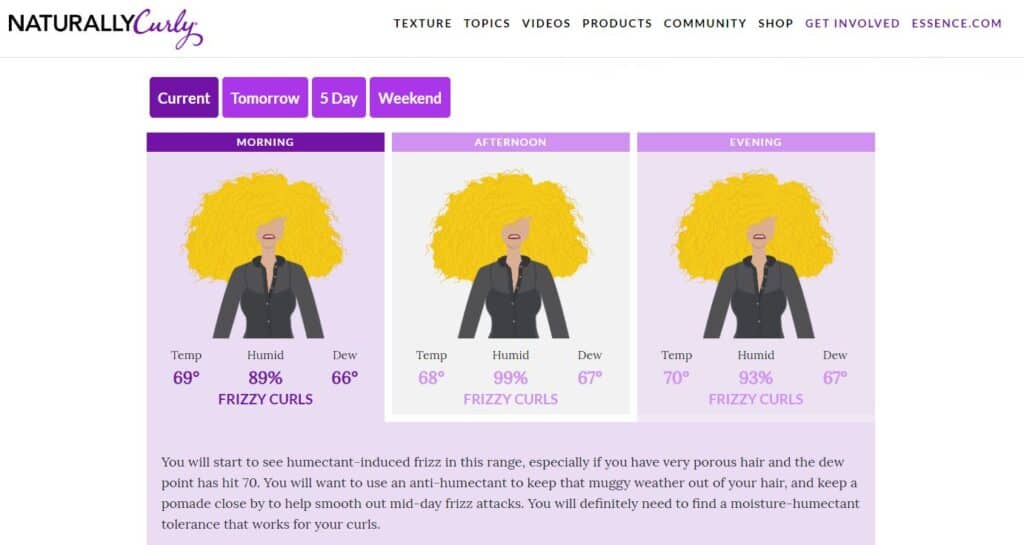
I also think it’s a good idea to record the products you’re using along with the dew point and temperature so that you can keep track of what works and what doesn’t. You can do this on your phone or using this curl tracker which will make it easier.
Low/Dry Dew Point
Low dew point is when the dew point is below 35 degrees Fahrenheit. In low dew points your hair will release water when using humectants. In this environment you want to avoid humectants because they can cause dryness, flyaways, split ends, and breakage.
Film-forming humectants can work because they retain some water in the hair.
DO: leave-in conditioner, light hold products, emollients, fatty alcohols, keep curls well hydrated
AVOID: humectants
High Dew Point
High dew point is when the dew point is above 60 degrees F (15C). In high dew points your hair will absorb water from the atmosphere and result in frizz. High porosity hair is also generally more affected by this.
In this environment, you want to use anti-humectants and emollients to seal the hair, smooth the cuticle, and prevent water from being absorbed into the hair and causing frizz. Also, you can skip leave-in and use hard hold styling products and products with humidity resistant ingredients.
DO: hard hold gel, anti-humectants, humidity resistant ingredients, emollients, lightweight moisture
AVOID: humectants, maybe leave-in, heavy moisturizing products
Mid Range Dew Points
Mid range is when the dew points are between 30-40 degrees F (-1-4C). This is usually in between seasons and will require trial and error to see what your hair likes. Some curls tolerate humectants in this range, but some don’t.
There is nothing specific to use or avoid in this range as it differs for everyone. Experiment and see what works for you.
Optimal Dew Points
Between 40-60 F (4-15C), this range is known as the one that will give you your best curls.
Humectants function best in this range. You can use emollients, medium hold products, and as always keep your hair moisturized.
If you want to have a handy little guide to dew points and ingredients be sure to download my Dew Points & Weather Styling Guide. It’s a great resource to have on your phone or print out so you can reference it when choosing your products.
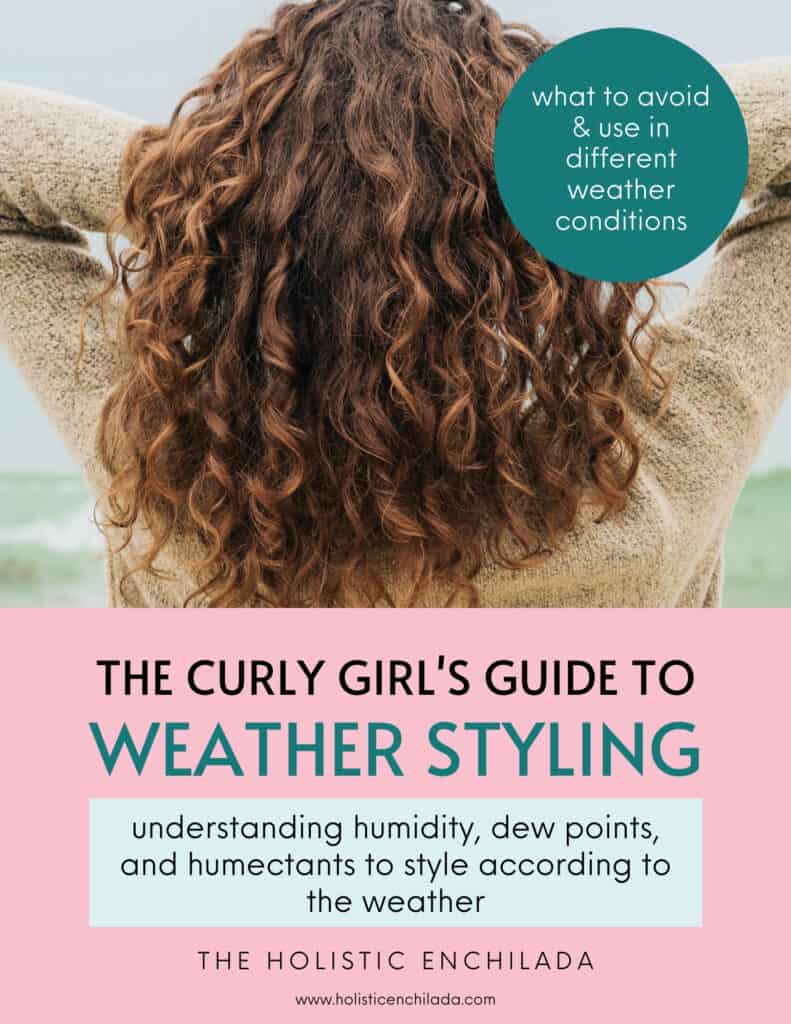
If you want help with embracing your naturally wavy or curly hair, you can join my FREE email course and download my FREE pdf guide, THE QUICK START GUIDE TO MASTERING YOUR CURLS, full of everything you need to know to get started and bring out your beautiful waves and curls.
You can also read my other popular posts on curly hair:
- A Basic Guide to the Curly Girl Method for Wavy & Curly Hair
- What Products You Really Need To Start The Curly Girl Method
- Curly Girl Method Routine for 2B 2C 3A Hair
- 50+ Curly Girl Method Approved Products
- Curly Girl Night Routine To Protect Your Curls At Night
- How To Refresh Curly Hair
- Tips For Fine & Low Density Curly Hair
- How To Clarify Curly Hair
- Rice Water Rinse Guide
- 14 Hacks For Curly and Wavy Hair
- How To Repair Damaged Curly Hair
- Curly Girl Method Before and After – 1 Year Progress Update
- Ultimate Guide to Hair Porosity for Curly Hair
- My Favorite Products for Fine Curly Hair
- 11 Surprising Reasons You Have Frizz + Tips to Beat Frizz
- Common Causes of Limp Curls & Their Fixes
- Guide to Humidity & Weather Styling
- EVOLVh Review
Want to remember this? Save The Curly Girl’s Guide to Dew Points, Humectants, & Humidity to your favorite Pinterest board.

Fabulous Curls Academy
Fabulous Curls Academy is my monthly membership program that gives you access to several online courses that will guide you through creating a simple routine that gives you fabulous results. Learn what your hair type is, which products and ingredients will work for you, and how to style according to your hair type by creating a simple routine that works. No more confusion about products or methods or battling frizz and time. Click here for more info.



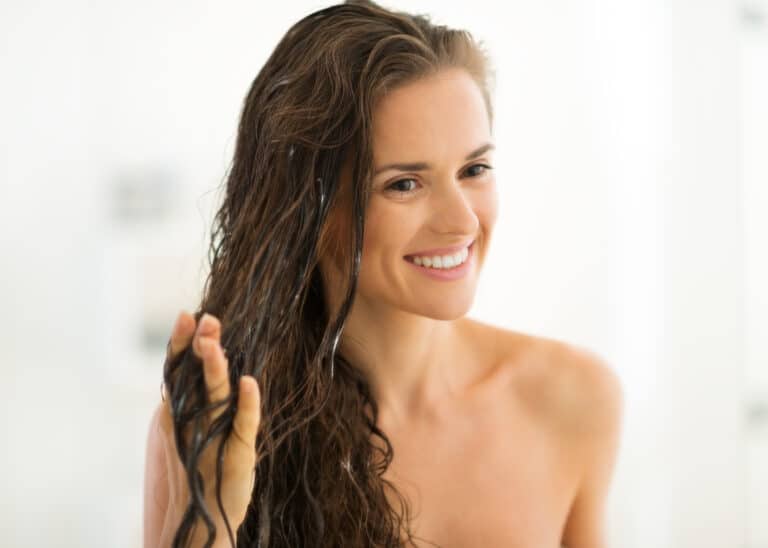
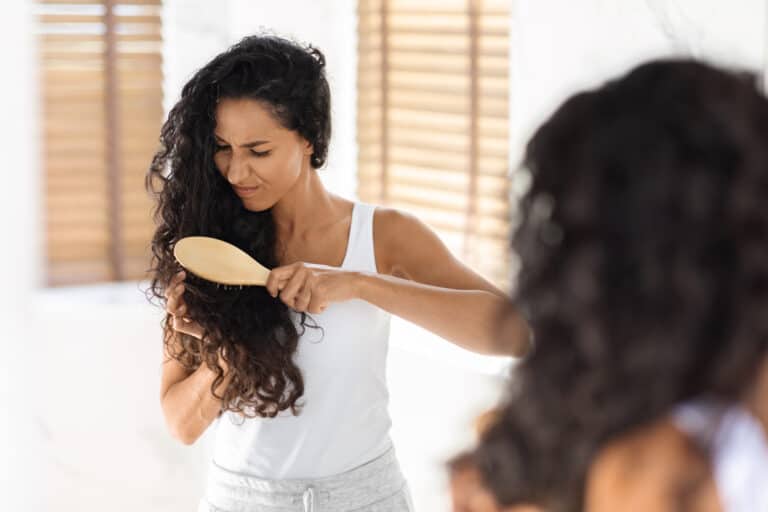

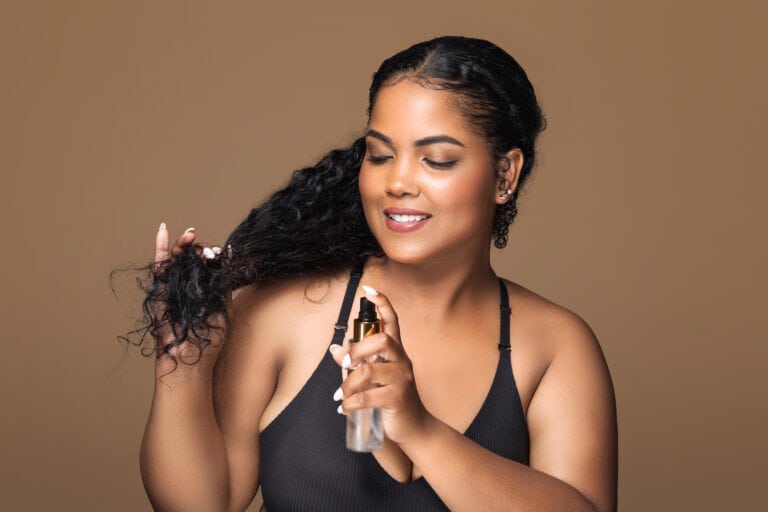
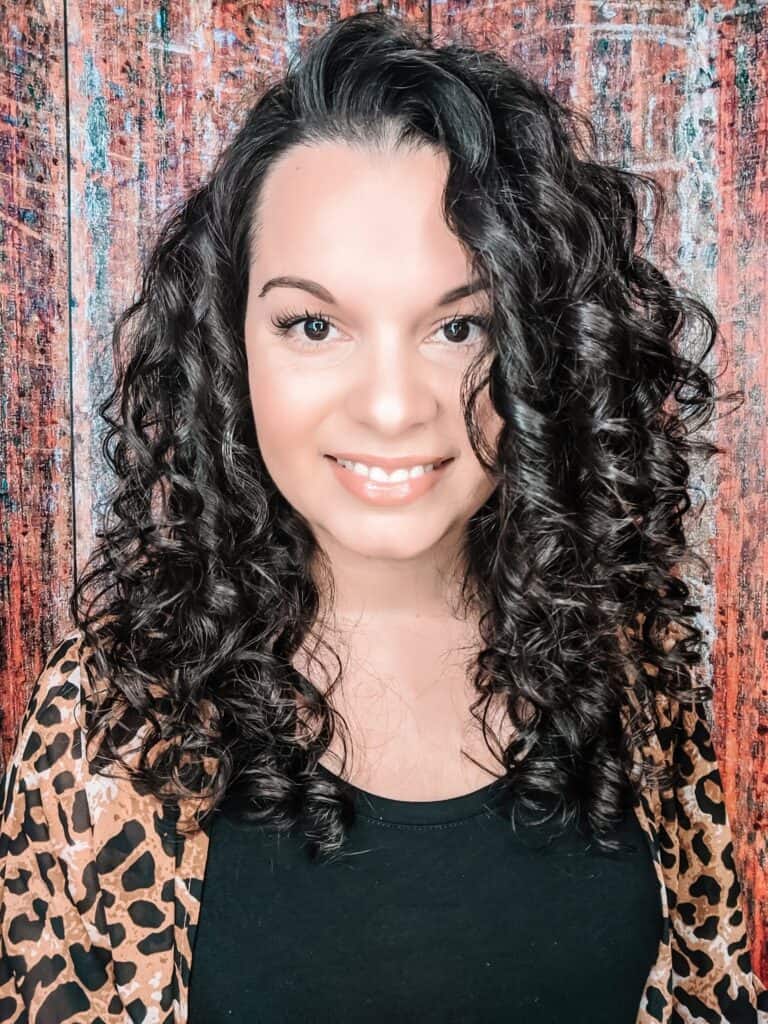

You have a link to the frizz forecast but some of those products definetely have glycerin and are not curly friendly in high due points. So that website may be for products that they want to push but not realistic. I know. I have spent a small fortune trying to apply products that work for me….I live in MIami , Florida
Yes the link is just to use the resource for styling tips, not product recs. I can make a note of that. Thanks!
Great article! Very informative. Thank you!
One question that I hope you might can answer. No matter what the dew point is or what product I use, my hair looks *instantly* greasy if I use anything with glycerin. I mean oil slick greasy. Any idea what that would indicate?
Thanks!
That is very strange but if you see a negative correlation with glycerin then just avoid it. Not sure why it would make your hair greasy. Perhaps too much moisture? Usually, people who can’t use glycerin have a flash drying effect so your reaction is definitely rare!
Thank you for the article! I’m having trouble understanding how to use emollients and humectants at the same time. It seems like the emollient would seal the hair off from the environment and keep humectants from moving moisture into the hair, dew point permitting. I’m just curious because I’ve noticed products with both emollients and humectants at the top of the list and I’m not sure how/when to use them!
Emollients help reduce the negative effects of humectants in regards to humidity and dryness because they seal the hair. Sometimes the formulation also includes hold and sealing ingredients like polymers that also provide protection. So it’s tricky to pinpoint but I would say if a product has humectants but it also has oils, butters, polyquats, and film forming humectants it should not be an issue.
Frizz Forecast looks like an amazing tool! I can’t seem to find it anywhere on their site however… do you happen to know if they took it down for some reason?
It looks like it has been removed. Such a shame because it was great.
Love the info!! THANK YOU!
I am not seeing that Naturally Curly Frizz Forecast is active anymore?? I used to use it every day! but have noticed over the last several months it does not seem to be there any longer? I have tried thrush link in your articles well with no luck!!! Any ideas or it is just me?
It seems to have been taken down, unfortunately. I’ll need to update this post.
There is a Frizz Forecast App built with OpenMeteo Data.
Hopefully this helps. I also gives you hourly Forecast with relative humidity, dew points, wind, and temperature. I see a lot of people using this now daily.
https://salonworthyhair.com/frizz-forecast-app
btw Delilah, love your detailed and thorough article.
Thanks for sharing! I will check that out.